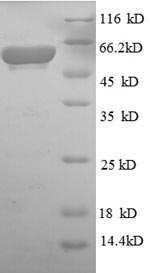Amino acids 1-501 constitute the expression domain of recombinant Escherichia coli (strain K12) glpD. This glpD protein is theoretically predicted to have a molecular weight of 60.8 kDa. This protein is generated in a e.coli-based system. The N-terminal 6xHis tag was smoothly integrated into the coding gene of glpD, which enables a simple process of detecting and purifying the glpD recombinant protein in the following steps.
The Escherichia coli aerobic glycerol-3-phosphate dehydrogenase (GlpD) is an enzyme that plays a crucial role in glycerol metabolism. Specifically, GlpD catalyzes the conversion of glycerol-3-phosphate to dihydroxyacetone phosphate while transferring electrons to molecular oxygen. This process is part of the aerobic respiration pathway in E. coli, contributing to the generation of energy and metabolic intermediates. Research on GlpD in E. coli is significant for understanding bacterial energy metabolism and adaptation to different environmental conditions. The enzyme's involvement in glycerol utilization is particularly relevant for bacteria that encounter varying carbon sources, such as those transitioning between anaerobic and aerobic conditions. Investigating the structure and function of GlpD can provide insights into the regulation of glycerol metabolism and its importance in bacterial physiology.






